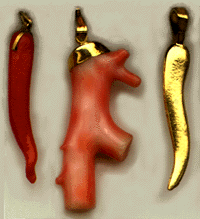Italian folk magic amulets: Corno
/ The cornuto, corno, or cornicello is an Italian amulet of ancient origin. Corno means "horn" and cornicello means "little horn" -- these names refer to a long, gently twisted horn-shaped amulet worn in Italy to protect against the evil eye. Cornicelli are usually carved out of red coral or made of gold or silver. The type of horn they are intended to copy is not a curled-over sheep horn or goat horn but rather like the twisted horn of an African eland or something similar. Over the years they have become rather stylized and now look less like a natural animal horn than they once did. A regionally popular amulet, they are primarily found in Italy and in America among descendents of Italian immigrants. You can buy cornicelli at any Italian jewelry store in New York to this day.
The cornuto, corno, or cornicello is an Italian amulet of ancient origin. Corno means "horn" and cornicello means "little horn" -- these names refer to a long, gently twisted horn-shaped amulet worn in Italy to protect against the evil eye. Cornicelli are usually carved out of red coral or made of gold or silver. The type of horn they are intended to copy is not a curled-over sheep horn or goat horn but rather like the twisted horn of an African eland or something similar. Over the years they have become rather stylized and now look less like a natural animal horn than they once did. A regionally popular amulet, they are primarily found in Italy and in America among descendents of Italian immigrants. You can buy cornicelli at any Italian jewelry store in New York to this day.
These little horns (like the horns of all horned animals) are presumed to have once been sacred to the Old European moon goddess, before the rise of Christianity. Some modern evangelical Catholics disparage the continued use of cornicelli among Italian Catholics and refer to them as "Satan's horns" or "Lucifer's horns" but this is absolutely nonsense, as they were always seen as the horns of the moon goddess -- and hence, in Catholic symbolism, would be related to the Virgin Mary, who is shown standing on a lunar crescent.
Related to the corno is the mano cornuta or "horned hand." This is an Italian hand-gesture (or an amulet imitative of the gesture) that can be used to indicate that a man has been cuckholded ("wears the horns") and also to ward off the evil eye. Mano means "hand" and corno means "horn."
The evil eye is believed to harm nursing mothers and their babies, bearing fruit trees, milking animals, and the sperm of men -- the forces of generation. The Neapolitan custom of making cornuto charms from silver (formerly sacred to the moon goddess Luna) and blood coral (formerly sacred to the sea goddess Venus) hints at the cultural survival of a link between the horned animal head and ancient worship of a neolithic-era mother- or fertility-goddess whose consort was a male deity sometimes called the Horned God. Whether or not this is the case, the cornuto is still a popular amulet worn by Italian men to protect their genitalia from the evil eye.
The apotropaic use of coral is evident in another Italian charm against the evil eye -- the coral twig. This is nothing more than a polished branch of pink or red coral, worn as a pendant or pin. Unlike the corno, which has a phallic import, the coral twig, which may resemble the branched horns of a deer, is considered suitable for girls or young women to wear. Also, not being hand-carved, it is a cheaper charm. It can be found in the form of a brooch as well as the traditional pendant.
The amulets shown at the top of the page are, from left to right, a red coral corno purchased in Florence, Italy in 1970, a coral twig amulet, and a modern pewter reproduction of a 19th century silver corno amulet. My mother, knowing how much i liked cornicelli, bought the coral one because i was pregnant. She intend to give it to my child if he was a boy -- but she did not show it to me at the time because my child turned out to be a girl, and the corno is only worn by boys and men. In 1995, when i started the Lucky W Amulet Archive, she brought it out of wherever it is that mothers keep such things and donated it to "the collection."
Less traditional than the coral corno is the giant red plastic one surmounted by a gold-toned crown shown at the [bottom]. I first saw these in the 1970s in New York and California, both regions with a large Italian-American population. Too big to be carried as a key ring, this 6" long crowned corno is designed to be hung from the rear-view mirror of a car. This usage derives from the ancient custom of protecting draft horses and mules from the envious eye of strangers, concern for their well-being being transferred to the automobile. This plastic charm is stamped "Italy," faintly visible below the crown. Non-Italians who see them in cars sometimes think these cornos are giant chili peppers, but such is obviously not the case.
copyright � 1995-2003 catherine yronwode. All rights reserved.
